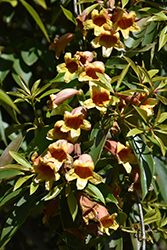Height: 20 feet
Spread: 24 inches
Sunlight:
![]()
![]()
Hardiness Zone: 6b
Other Names: Trumpet-Flower Vine
Description:
Beautiful clusters of orange-red trumpet flowers grace this vigorous and tall-growing glossy-leaved vine; the flowers are attractive to hummingbirds and butterflies; needs a sturdy structure for support
Ornamental Features
Cross Vine features showy red trumpet-shaped flowers with yellow throats along the branches from early to late spring. It has green deciduous foliage. The glossy narrow leaves do not develop any appreciable fall colour. The fruits are showy brown pods displayed from late summer to early fall.
Landscape Attributes
Cross Vine is a multi-stemmed deciduous woody vine with a twining and trailing habit of growth. Its average texture blends into the landscape, but can be balanced by one or two finer or coarser trees or shrubs for an effective composition.
This woody vine will require occasional maintenance and upkeep, and is best pruned in late winter once the threat of extreme cold has passed. It is a good choice for attracting bees, butterflies and hummingbirds to your yard. Gardeners should be aware of the following characteristic(s) that may warrant special consideration;
- Spreading
Cross Vine is recommended for the following landscape applications;
- Mass Planting
- Hedges/Screening
- General Garden Use
Planting & Growing
Cross Vine will grow to be about 20 feet tall at maturity, with a spread of 24 inches. As a climbing vine, it tends to be leggy near the base and should be underplanted with low-growing facer plants. It should be planted near a fence, trellis or other landscape structure where it can be trained to grow upwards on it, or allowed to trail off a retaining wall or slope. It grows at a fast rate, and under ideal conditions can be expected to live for approximately 20 years.
This woody vine does best in full sun to partial shade. It is very adaptable to both dry and moist growing conditions, but will not tolerate any standing water. It is not particular as to soil type, but has a definite preference for acidic soils. It is highly tolerant of urban pollution and will even thrive in inner city environments. This species is native to parts of North America.
Disclaimer - This resource is provided for informational purposes only and does NOT reflect current availability. Inventory varies seasonally, so we cannot guarantee that every plant will be in stock at all times - please contact your favourite GardenWorks location directly for current availability. It does not include our entire inventory of plants, so be sure to visit GardenWorks to see varieties that may not be represented on this list.



